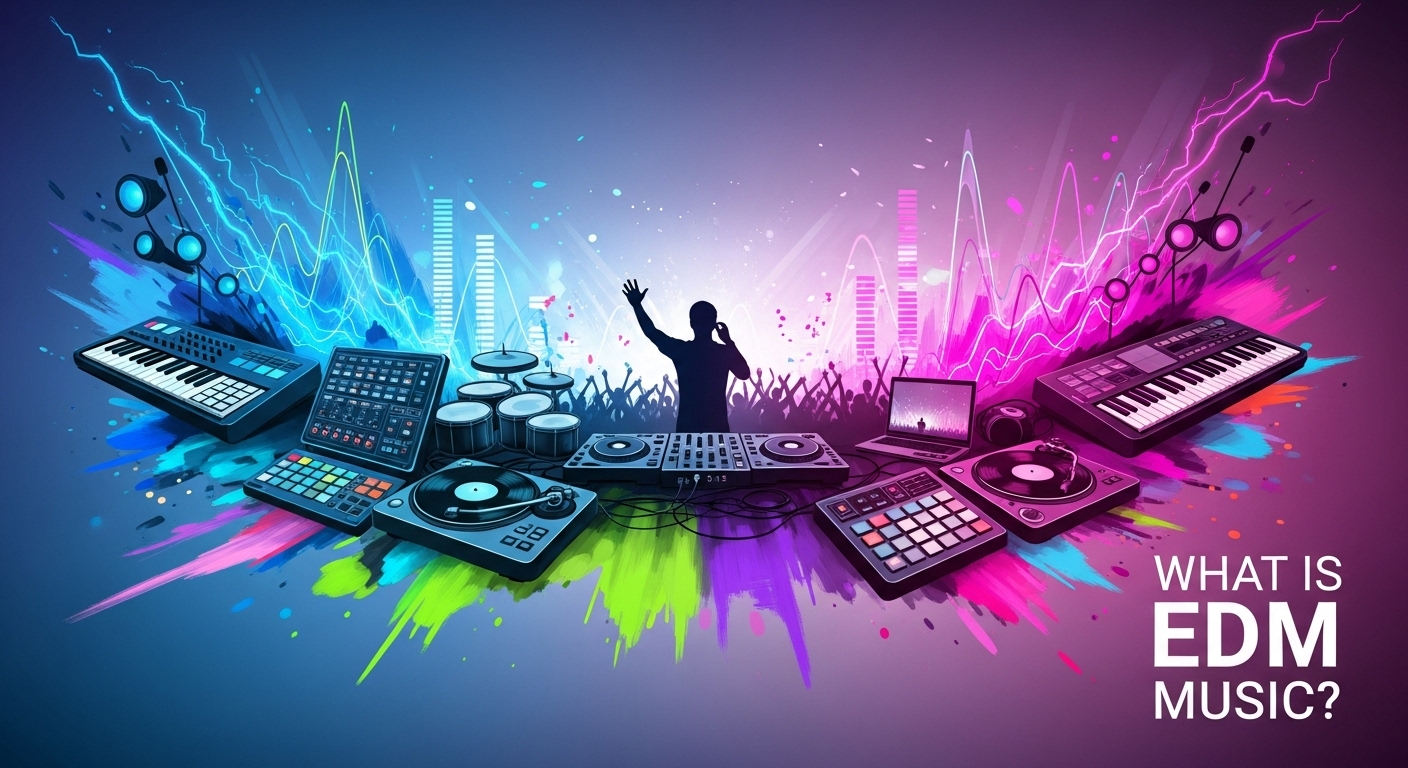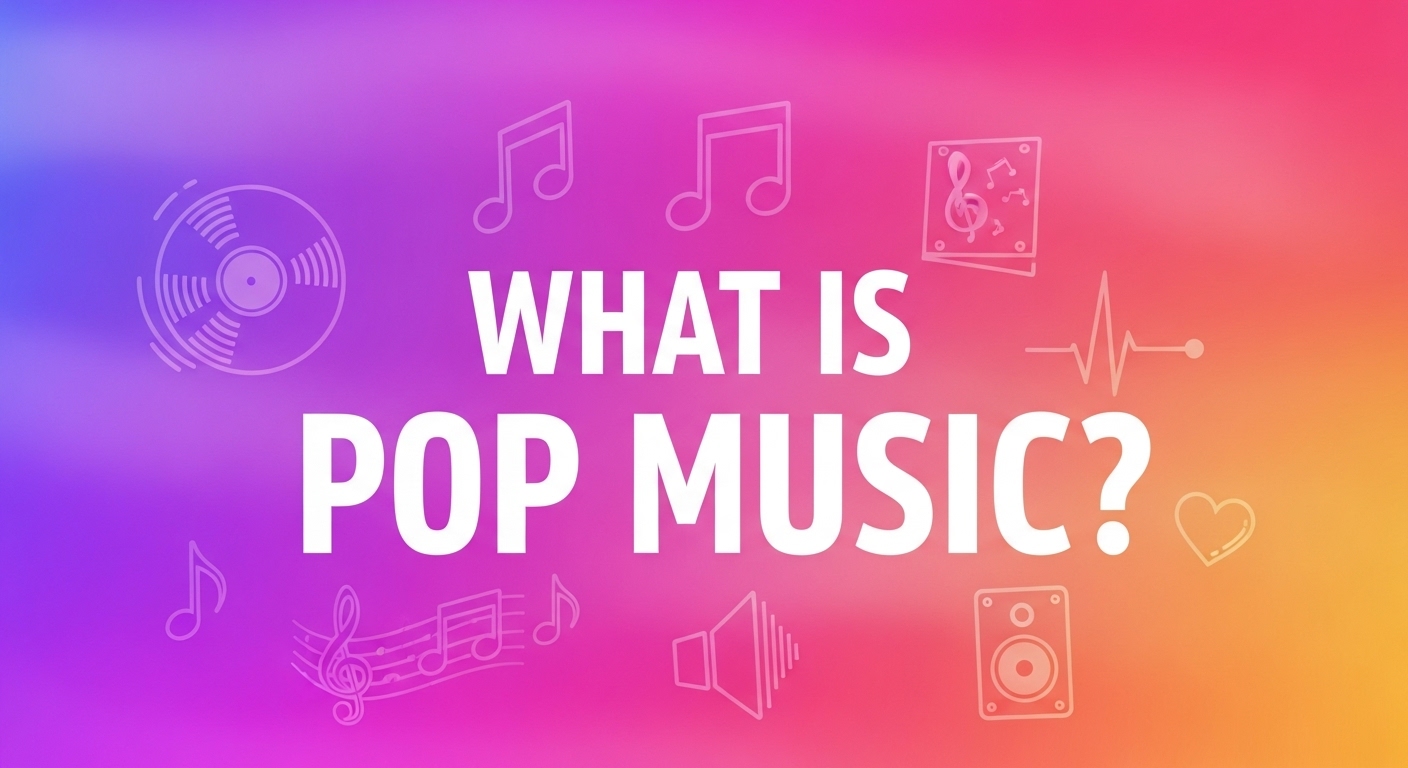

Areeba Imran
Wed Aug 06 2025
7 mins Read
EDM stands for electronic dance music, a genre powered by digital tools, created to energize, engage, and, of course, make people dance. From being popular at nightclubs and festivals to your daily playlist, EDM (acronym for electronic dance music) has grown into one of the most influential musical forces in the world. Let’s explore where it came from, what it sounds like, how it evolved, and how even you can make your own EDM tracks today, no studio or instruments needed.
What Is EDM Music?
Electronic dance music is a wide category. At its essence, it is music created with electronic instruments such as synthesizers, drum machines, sequencers, and computer software, among others. Recently, DAWs have gained popularity in the scene. These tools enable producers to create layered compositions with correct rhythms, expressive tones, and irresistible beats that, when dropped, get everyone bopping.
EDM is typically instrumental; however, vocals are frequently included for texture or narration. EDM vocals are typically mellow, similar to those of a narrator or ballad singer. Unlike conventional music, which is based on live performances, EDM flourishes in studios and, more and more, on laptops and mobile applications.
It’s called “dance music” because it’s designed to move people, but that doesn’t mean it’s all high-energy noise. EDM encompasses mellow, ambient tracks ideal for studying or relaxing, as well as explosive beats suitable for massive music festivals.
A Timeline of EDM’s Origins and Evolution
The Origin Story: 1970s–1980s
In the late 1970s, technological advances offered up new avenues for music. Artists and Producers began to experiment with synthesizers and drum machines. Disco was the era's musical genre, but a fresh concept was forming beneath it. House music originated in Chicago clubs such as The Warehouse, where DJ Frankie Knuckles extended dance records with drum machines. At the same time, pioneers such as Juan Atkins and Derrick May helped Detroit grow as a technological hub. In Europe, Kraftwerk inspired an age of electronic musicians by combining robotic tones and mesmerising sounds.
The Global Takeover: 1990
The 1990s were a golden age of electronic dance music. While EDM remained underground in the United States, Europe embraced it wholeheartedly. Drum and bass, jungle, and garage exploded in the United Kingdom's party scene. Germany established large electronic scenes in Berlin. Ibiza, Spain, has transformed into a DJ and party hotspot, conducting week-long dancing marathons under the sun. Trance and eurodance (think ATB, Paul van Dyk, and Darude) dominated clubs. Dance music has also permeated pop, with groups such as Daft Punk blurring the barrier between underground and pop.
The Most Played Genre: 2000s–2010s
The 2000s saw the rise of superstar DJs. Tiësto, Armin van Buuren, and David Guetta went from clubs to arenas. In the late 2000s and early 2010s, the U.S. finally caught up, and the “EDM boom” began.
Tracks like:
- “Levels” by Avicii
- “Scary Monsters and Nice Sprites” by Skrillex
- “Don't You Worry Child” by Swedish House Mafia
- “Clarity” by Zedd
Became global hits. EDM festivals like Ultra Miami, Tomorrowland in Belgium, and EDC Las Vegas attracted hundreds of thousands of fans.
EDM wasn’t just a genre; it was a movement, a lifestyle, and a billion-dollar industry.
Where Is EDM Music Most Popular?
Electronic dance music knows no borders. With the internet, social media, and music streaming, EDM spread rapidly across the globe. Here’s where it thrives today: United States: Once a late bloomer, now a global EDM hub. Major festivals and headlining DJs come out of the U.S. every year.
Europe:
Europe is the birthplace of many styles, with thriving underground and commercial scenes. The underground club and rave scene in Europe has given EDM a whole new rebellious feel.
Latin America:
Countries like Brazil and Mexico have booming EDM scenes and world-class festivals like Lollapalooza and Ultra Brazil.
Asia:
Rapid growth in countries like India, Japan, and South Korea has been fueled by youth culture and digital access.
Australia:
Hosts large-scale EDM festivals and supports a strong community of local producers and fans.
No matter where you go, from Berlin to Bangkok, Las Vegas to Lima, EDM is part of the global soundtrack.
EDM Sub-Genres You Should Know
If you’re wondering what EDM music is, you might be surprised to learn that it’s not just one sound. It’s dozens, maybe even hundreds, of styles. Here are some of the most influential:
House:
Smooth, repetitive beats around 120–130 BPM. Easy to dance to, often with soulful or vocal elements.
Track example: “One More Time” – Daft Punk
Techno:
Industrial, hypnotic, and often minimal. Focused on rhythm over melody.
Track example: “Spastik” – Plastikman
Trance:
Melodic, emotional, and euphoric with long build-ups and breakdowns.
Track example: “Adagio for Strings” – Tiësto
Dubstep:
Known for its wobbly basslines and epic drops. Heavy and aggressive.
Track example: “Bangarang” – Skrillex
Drum and Bass:
Fast (160–180 BPM), breakbeat-heavy, and bass-driven.
Track example: “Timewarp” – Sub Focus
Trap:
A darker, hip-hop-influenced EDM style with booming 808s and crisp hi-hats.
Track example: “Harlem Shake” – Baauer
Future Bass:
Lush synths, huge chords, and emotion-packed drops.
Track example: “It’s Strange” – Louis The Child
Ambient/Chillstep:
Slower, more atmospheric, and great for relaxing or studying.
Track example: “Sun” – ODESZA
There’s an EDM sub-genre for everyone. Whether you’re into mellow soundscapes or heart-pounding drops, you’ll find something that fits your vibe.
Why EDM Is Still Going Strong
EDM’s longevity isn’t luck. It’s built into the genre’s DNA:
- It adapts: EDM producers constantly blend genres, remix styles, and invent new sub-genres.
- It’s global: No language barrier, just beats and emotion.
- It’s creator-friendly: Anyone with a laptop can learn to produce EDM.
- It fits every moment: Party, relax, focus, exercise, EDM has moods for all.
Today, EDM is as alive as ever, fueled by TikTok trends, YouTube remixes, Spotify playlists, and creators from every continent.
EDM and the Rise of AI: Enter ImagineArt Music Studio
In the past, making EDM meant buying software, learning production skills, and spending hours fine-tuning your track. Not anymore.
ImagineArt Music Generator is here to change how people create electronic dance music. Whether you’re a total beginner or a content creator looking for the perfect background track, ImagineArt uses powerful AI to help you build professional EDM in minutes.
Here’s how it works:
- Pick a style: Choose your favorite sub-genre, house, trance, dubstep, ambient, etc.
- Set the mood: Select a vibe like uplifting, chill, dark, or romantic.
- Generate a track: The AI creates a full instrumental track in seconds.
- Customize it: Edit tempo, melody, transitions, and even vocal hooks.
- Download royalty-free: Use your music for YouTube, TikTok, games, apps, anywhere, forever.
Who is it for?
- YouTubers: Create music for intros, vlogs, or tutorials.
- Game developers: Generate dynamic EDM scores or ambient loops.
- Social media creators: Get original, copyright-free beats for Reels or Shorts.
- Music fans: Just want to hear your own sound? Make it real in minutes.
ImagineArt makes it possible to create your own EDM, not someday, not after months of training, but right now.
Join the Worldwide Creator Community
When you use ImagineArt, you’re not just generating tracks, you’re joining a creative movement. ImagineArt’s user base includes people from all walks of life and locations:
- Bedroom producers in Berlin
- Gamers in Jakarta
- Influencers in L.A.
- Teachers in Toronto
All are using AI to create and collaborate on music that moves the world. Whether you're uploading your first beat or your hundredth, you're part of something global, growing, and electrifying.
Final Thoughts: To wrap it all up: what is EDM music? It's an international, rapidly changing genre that uses music to unite people. It is electronic dance music that originated in underground clubs and is now heard everywhere, including on video game soundtracks, TikTok videos, large festivals, and gym playlists. The best part, too? You can participate even if you're not a producer or DJ.
ImagineArt Music Studio enables you to make your own EDM mixes in minutes, utilizing strong AI. It's quick, entertaining, and absolutely free of royalties. So, whether you're a content creator, an aspiring artist, or simply someone who enjoys beats, now is your time.
Make your music. Share your sound. Join the EDM movement.
Frequently Asked Questions (FAQs)

Areeba Imran
Areeba Imran specializes in content marketing for GenAI and SaaS companies, helping them grow with strong writing and strategy.
